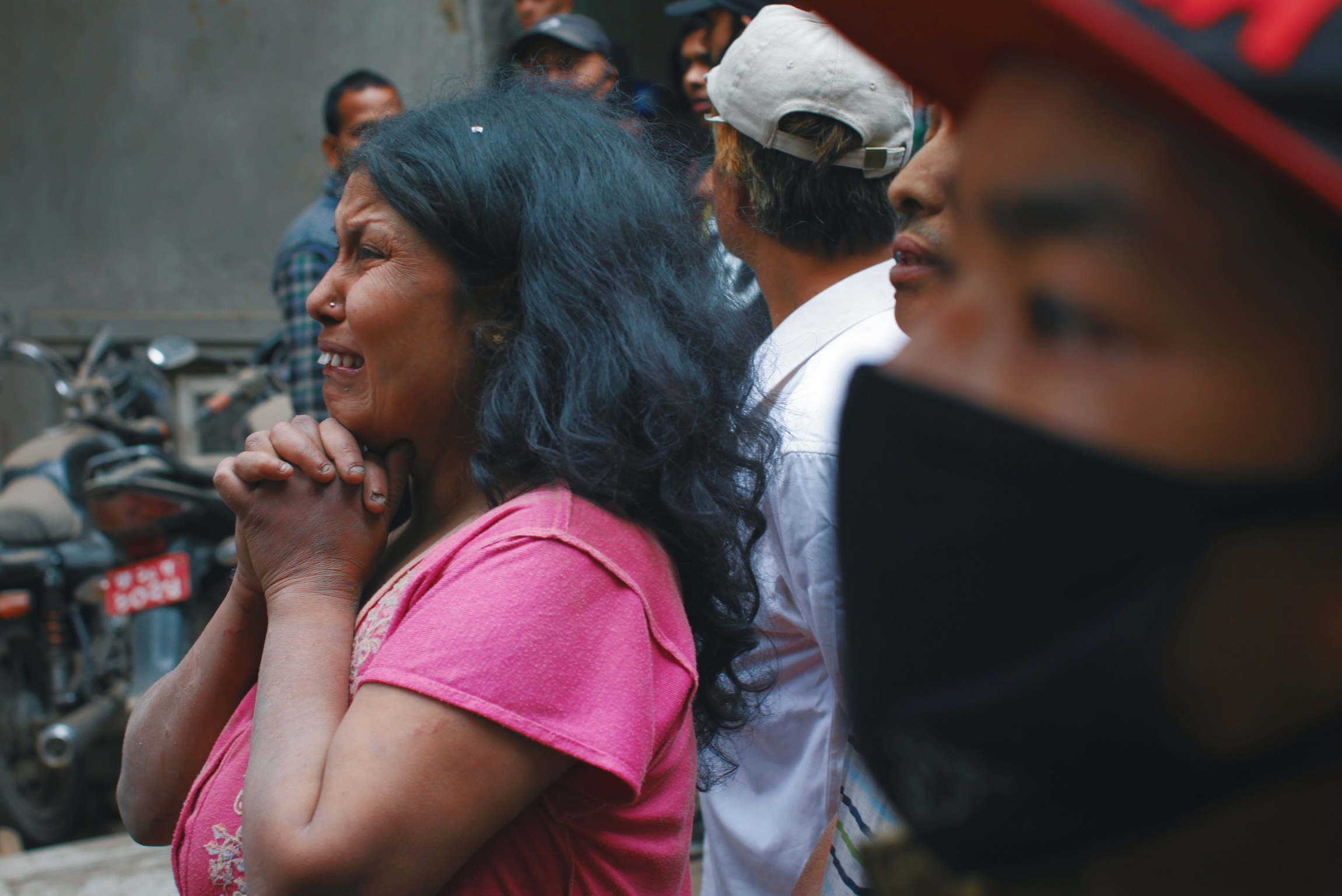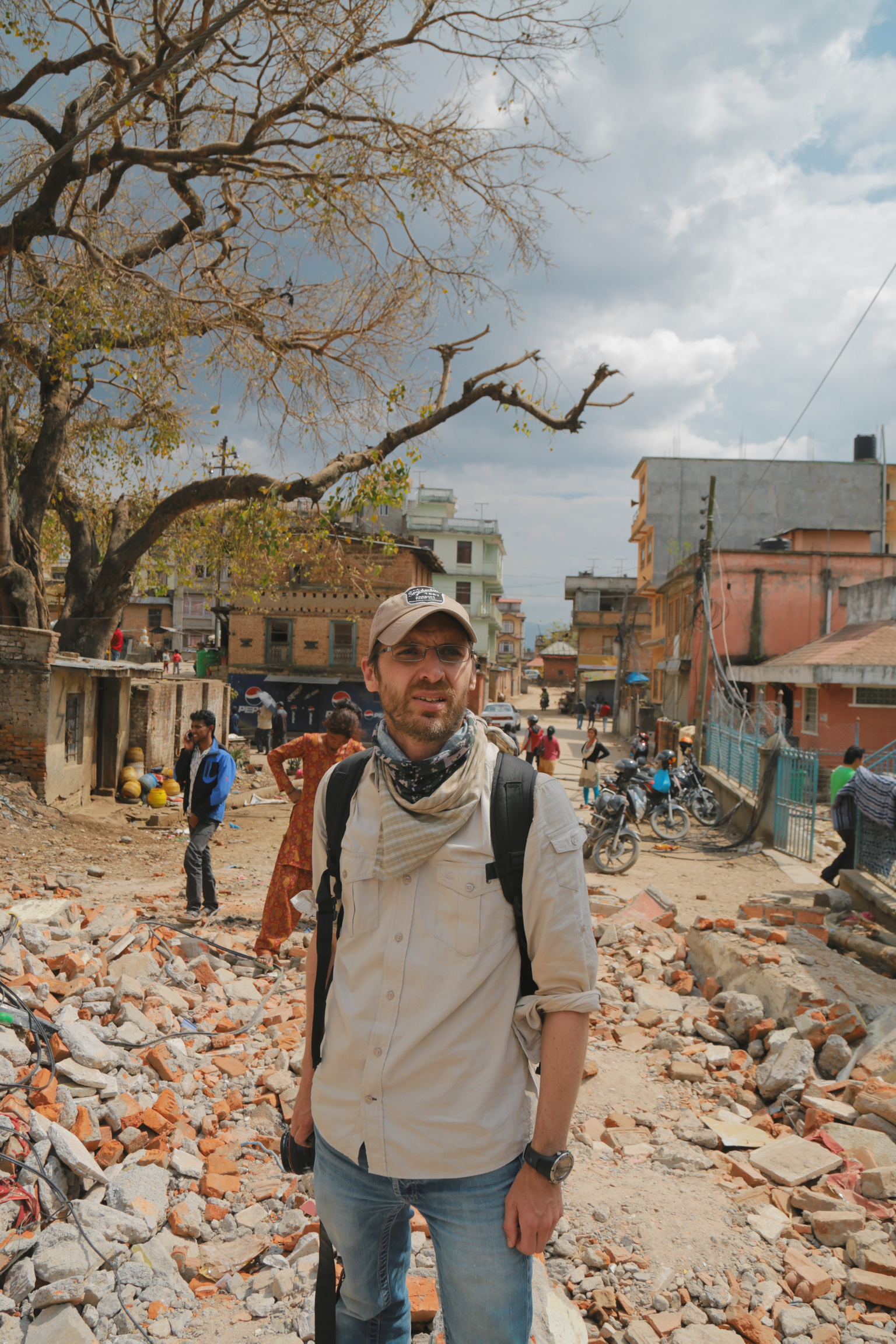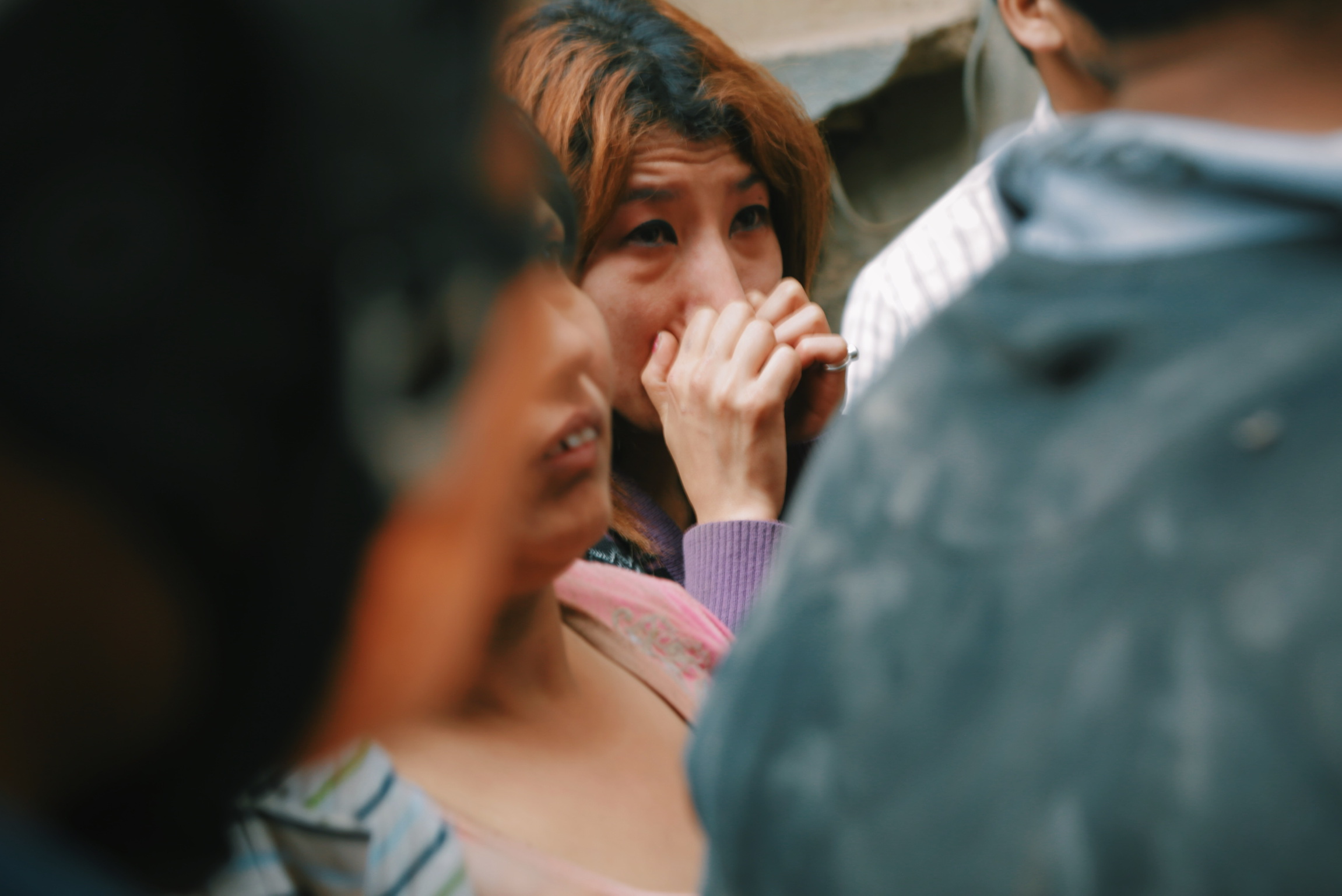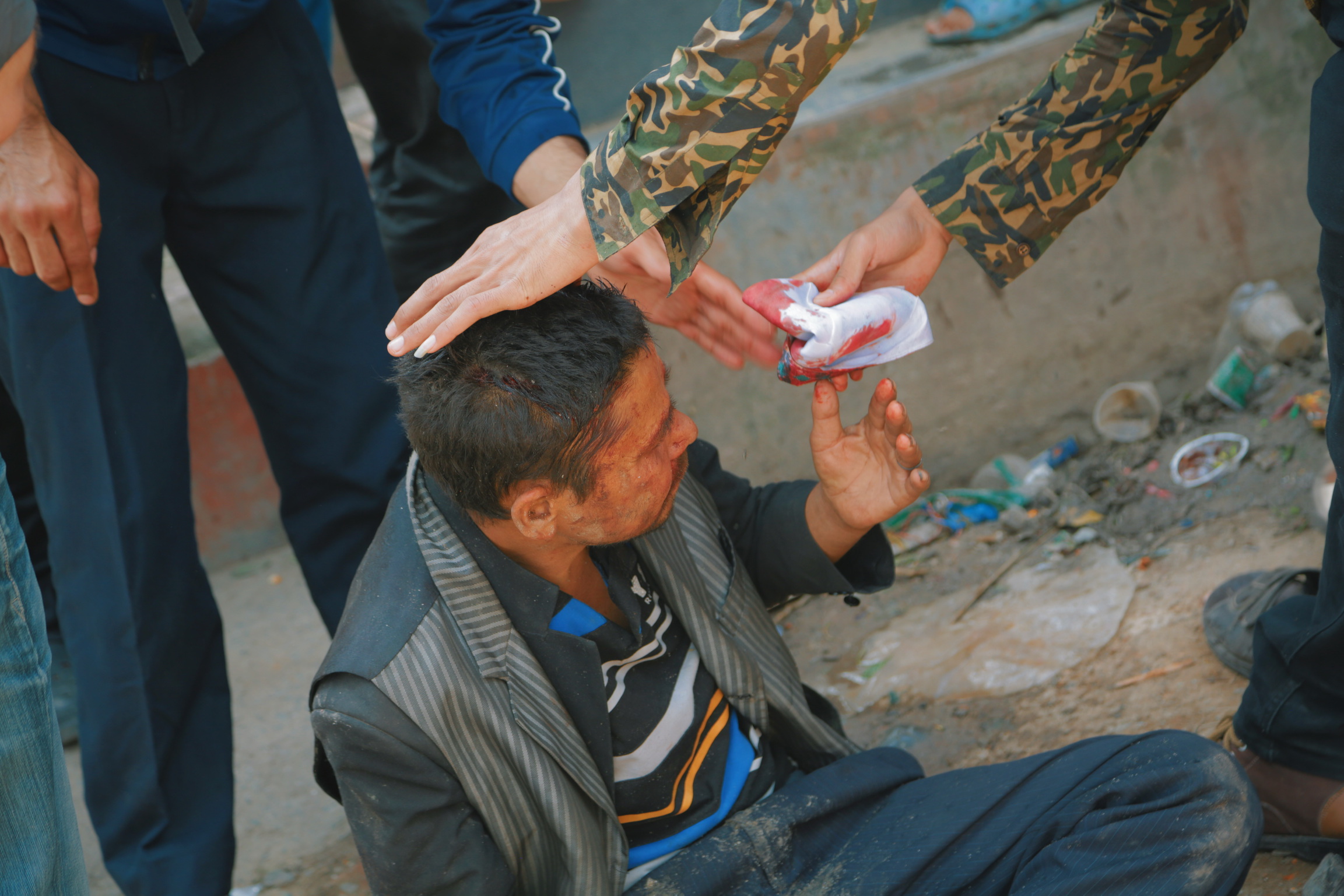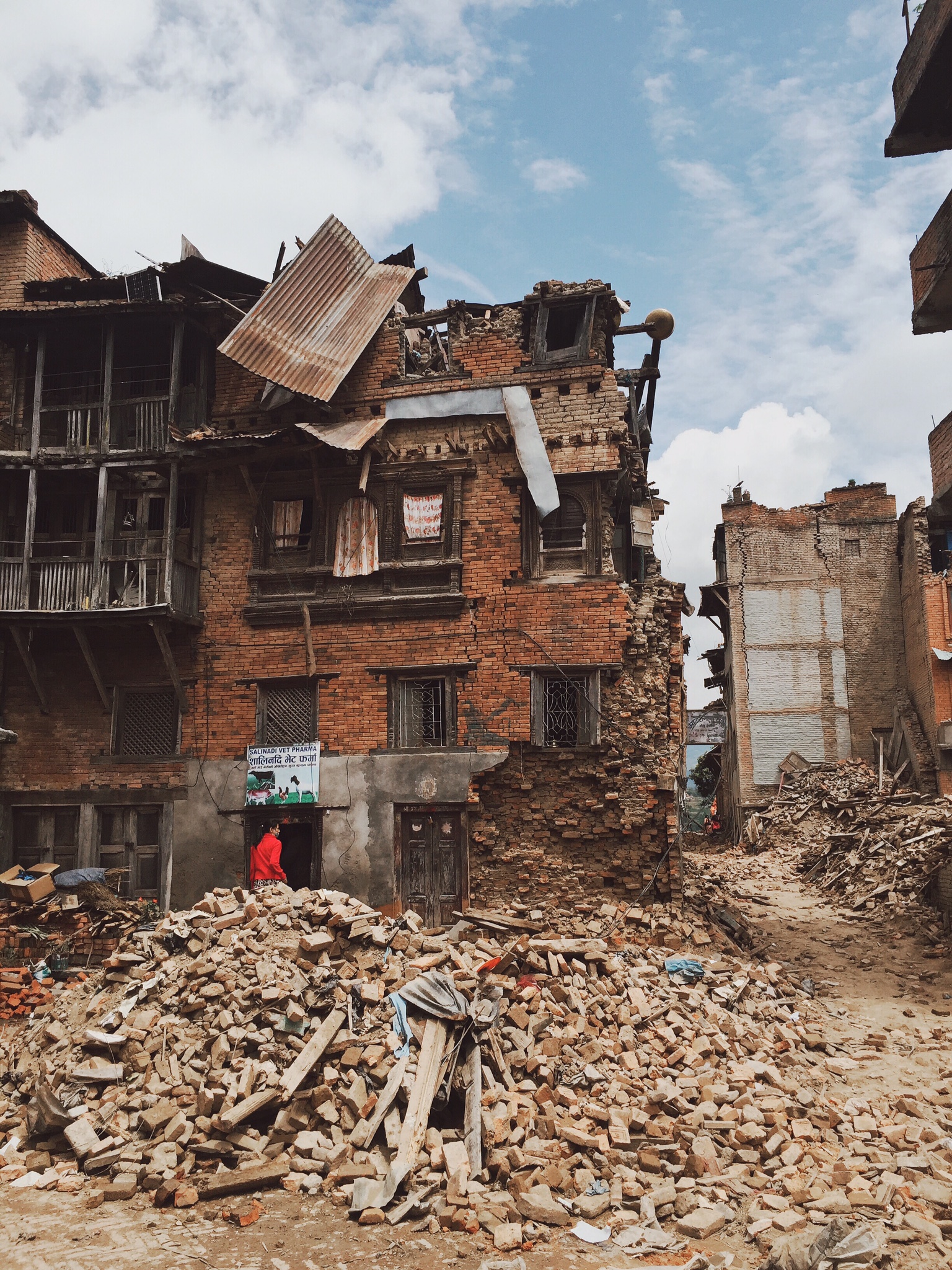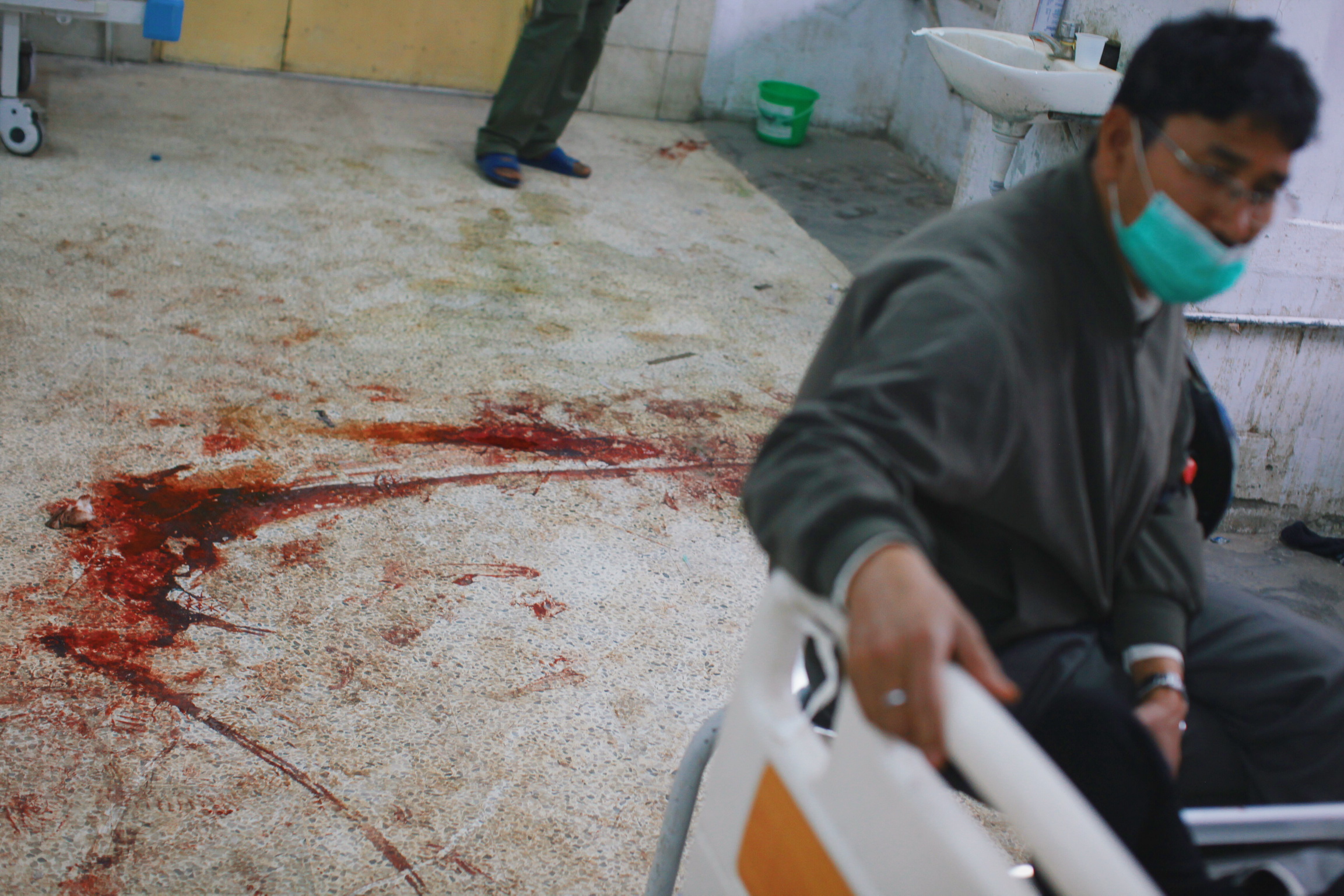The Earthquake: Day One - 11:56 AM Thamel District - Kathmandu, Nepal: A low rumble of what seems like a large truck passing by begins to vibrate the desk I am working at in our 2nd floor room. But something is different. The vibration begins to increase and I take my hands from the desk and lift them up like I have done something to cause this. I then look at a water bottle near me as it teeters around in a dancing motion and then falls to the ground. The deep rumble increases and the entire room begins to sway. I look over to William and both of our eyes grow wider as the vertigo motion takes hold. It feels as if we are aboard a ship in high waves and passing over debris. The rumble increases and from every direction we hear screams of terror. We hear dishes below in the courtyard restaurant smash to the ground and watch from our balcony a scene of panic. People struggle for balance as the earthquake begins to hit its zenith. The building we are in begins to flow in a motion like we are on an iceberg breaking violently away from land. A moment later, we come to our senses, grab our shoes, and run down the stairs while being thrown from side to side. When we make it to the courtyard, the rumble slowly subsides. We sit down for a moment and look at the others who have just felt the event. Everyone has a glassed-over look of wonderment and some even laugh nervously. As we head out to the narrow alleyway in front of the hotel, we see stores with their goods spilled out everywhere. We look inside one shop and notice a woman pinned under large shelving. The casing lays over her entire body just catching itself on an opposite wall. If the shelf was any smaller she would have surely been crushed to death. We duck down and drag the pinned woman out. Her arm is broken and she says, “thank you” to us many times as she emerges. She then gathers herself and embraces her teenage daughter. The woman says one final thank you to us and the two of them disappear down a side street. After a few moments, we notice a heavy panic beginning to set in as more and more people begin to run in every direction. We look to the sky and realize we are surrounded by towering buildings that are constructed with the lowest of standards. Spiderweb type cracks form down the sides of each building near us and all of sudden we feel like ants amongst giant dominos. Time to get out of here. We ask someone where open ground is and run for five minutes down the street. As we run, we manage to send two text via our cell phones to let loved ones know we are okay. They read: Just had a massive earthquake here. We are okay. Going to open ground. Knowing phone lines will soon be cut we hope the messages get out. Once at the intersection, we are somewhat relieved from the crushing feeling that we are completely surrounded by tall buildings. However, the skyline in this place is filled with a dangerous array of messy electrical wires that hang overhead. Additionally, there are other tall buildings nearby that would be lethal if they were to fall. I would hesitate to call this open ground, but in the scheme of things it feels much better than the place we just were. As we observe the scene, a crowd of hundreds begin to gather, they stand in a tight group almost embracing one another. Each person looks nervously around with rapid head and eye movements like people suffering insane delusions, but this is no delusion— it is total fear of what might come next. Shop owners, tourists and local residents all make up this huddle and scared group; everyone is equal, everyone is hoping to survive. We move slightly away from this crowd because the danger of a panicked stampede is highly likely. Ten minutes later, as we stand on a small dirt mound while filming the scene, the earth suddenly begins to shake again. Once more, the terrifying swaying motion and the deep rumble hits us—another earthquake. The deep growl of this quake sounds like the earth is letting out a demonic moan (this aftershock was later verified as a 6.6 earthquake itself). Screams of absolute terror lift up from the crowd as the rumble and shaking continues. Even though this group is standing in a somewhat open area, they duck and flinch in horror. There is a frightening unison to movement of the crowd. The terrified screams, the rapid ducking, the hands over their heads, it all feels like the apocalypse. It is a moment we know we will always remember, for in these minutes, each person felt as though their world was ending.
After the second earthquake subsided, everyone begins to realize the magnitude of the event. Shock gives way to fear and fear to hysteria. People begin to run, but no one has a direction in mind other than to run to the large open stadium.
As people flee we looked down the streets to where we just came from. Inside the narrow alleyways, we spot a large plume of dust. There is a crowd gathering near a corner and we can see that a two story shop has collapsed. We run towards it and enter the alleyways once more. When we arrive, a crowd of frantic people are digging at the rubble and someone tells us there is a person trapped below. They dig and dig with so many people that it is impossible to get close enough to help. At this site, around 40-minutes after the first 7.8 earthquake, a small hole is made and a man impossibly squirms out to the shouts of jubilation from the crowd. His eyes are faint and legs weary. The excited crowd tries to hoist him up like a conquering hero, but many of us witnessing the scene shout, “Be careful! He might be hurt.” His family cries as they embrace him. The raw emotional impact grips everyone who is watching and many others begin to cry also. Moments later, the man is quickly whisked away on a motorbike and taken to a hospital.
After this incredible rescue, we walk further into the alleyways. Then, only three blocks away we see yet another crowd gathering at a large 4 story building. The building is partially collapsed on the inside and two of the four walls are down. A mother and father, covered in dirt, shout and move about frantically. The police and a military rescue team have already, surprisingly fast, responded and are on the scene. There is a small window that the rescue workers are crawling through and they report they can touch the foot of one child. The mother, at this collapse, is crying and distraught. Five minutes later, another daughter to this distraught mother, arrives at the collapsed building. This woman is an older sister to the girls trapped inside, and upon seeing the downed home, falls to the ground with a wail of sorrow. Her mother embraces her and they cry in each others arms. Everyone near them can feel the emotional pain they are feeling and most duck their heads in sorrow. Oh God help them we pray to ourselves. We come close to the mother and sister and give them water and comfort them. They move about and plead with the rescue workers to go inside the partially collapsed house to see if the children are alive. It is dangerous and everyone is on edge. Some rescue workers decide to go into the basement area and we decide to follow an additional rescue crew into the second floor of the partially collapsed building. As we enter we feel a claustrophobia like never before. Then, as we walk gingerly up the stairs, the earth begins to shake again. The building moves violently and the sounds of cracks and pops echo through stairwells. I shout to Will, who is one flight of stairs above me, “Get out! Get out!” and before the words even exit my lips we are all running for our lives. The building teeters and crackles as we spill out of the structure in every direction. It doesn't collapse, but fragments fall all around us. Rescue teams shout and clear everyone to an area on the street side. The potential for all of us dying in that moment was extremely high. The mother, father, and daughter are surrounded by Nepalese police and rescue workers who try to console the family. One of the Nepalese policemen tells us in a whisper that there is little hope. The children are both lifeless and crushed and pinned under massive debris. Neither are responding. (Two days later, when we returned to verify if the children were in fact killed, we were told by a neighbor they both died. But in the opposite building, where another collapse occurred, two survivors were rescued).
Moving further into the historical city after leaving the sad scene of the family, we are told from people passing by, “Durbar Square is destroyed!” (Durbar Square is a famous and historical place well-known in Kathmandu). After hearing this, we rush down dangerous alleyways trying to make our way towards Durbar Square. We see buildings that reflect the magnitude of the disaster as we sprint by. Some looked as though they had been cut in half, exposing the contents inside like a child's dollhouse. Some were tilted and bowed, some were leaning against each other, while others were reduced to only a pile of bricks. The mass devastation became even more clear when we arrived at Durbar Square as almost every temple and building was destroyed. It was chaos and people were all stunned at the magnitude of what just happened. One man told us, as we looked upon Durbar Square, “Nothing like this has ever happened in my lifetime.”
On day one we moved throughout the city center, from rescue site to destroyed area, and even to the hospital where body bags flowed in by the hundreds while doctors worked heroically to save the lives of the injured. It was a day we we will never forget and it was a day we are thankful to have survived. That evening, as we reflected upon everything, we knew that God has placed us in Nepal for a reason. We knew we were sent here to help and we immediately began to formulate a plan of action. In the days that followed, we launched out on our own missions to deliver food aid, shelters, and supplies. We purchased goods from local storehouses and began taking loads out immediately. The devastation was extreme and we knew we had to act fast. At the beginning, we were the first to bring aid to regions no one had yet reached after the disaster. Moreover, we were able to preach the Gospel, pray for the sick, and see God change the hearts of many. The light shines brightest in the darkness and we thank God He set us in Nepal for such a time as this.







